Retracing the Detroit Grand Prix in a McLaren Senna
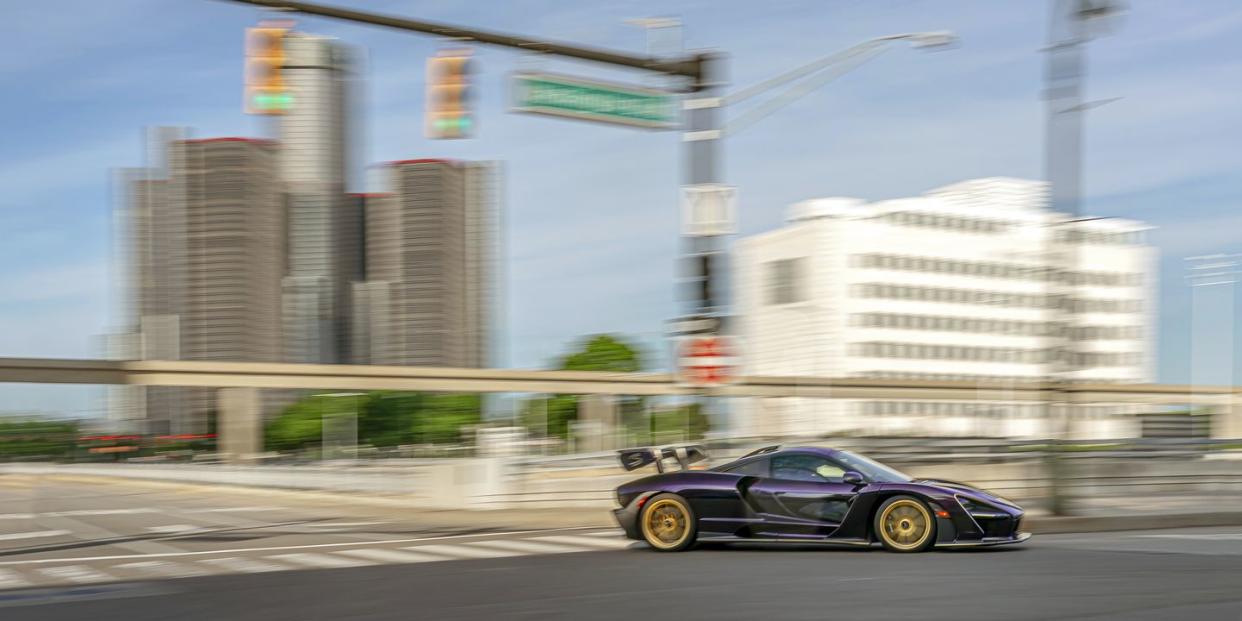
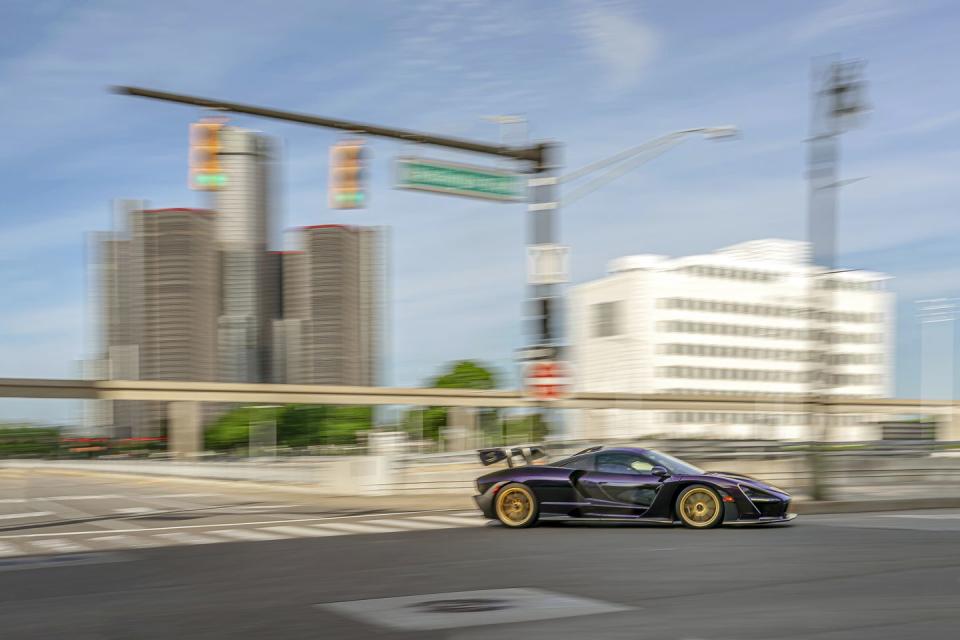
There is a teenage girl sprawled out on the concrete immediately behind the gold-edged rear diffuser of the $1.1 million McLaren Senna in which I’m sitting. She has just hit the car.
Well, it’s a “car” in the same way an F-22 Raptor is a “plane.” The fact is true, but the descriptor somehow misses the point. To me, at this moment, the Senna feels like a mobile Faberge egg—exquisite, fragile, and damn near irreplaceable. I’m frankly wishing that my signature was no longer the one on the loan agreement from McLaren Automotive.
Worst of all, I see it coming. Or rather, I see her coming. She’s riding one of those rental electric scooters that have spread, cockroach-like, through our cities. As I sit in the parked Senna with the A/C blasting to try and regain some of the energy sapped by the Detroit summer humidity, I track her unsteady approach in the rearview. But there is 50 feet of concrete to my right and at least 10 to my left. And I’m sitting in a vehicle that, with its purple paint job and gold trim, looks like a cross between a Le Mans prototype racer and a Crown Royal bag. It is impossible to miss. I can only assume she object-fixated on the Senna, as every onlooker does, and followed her eyes directly into the center of the rear end. “Bam!...thud…gasp!”
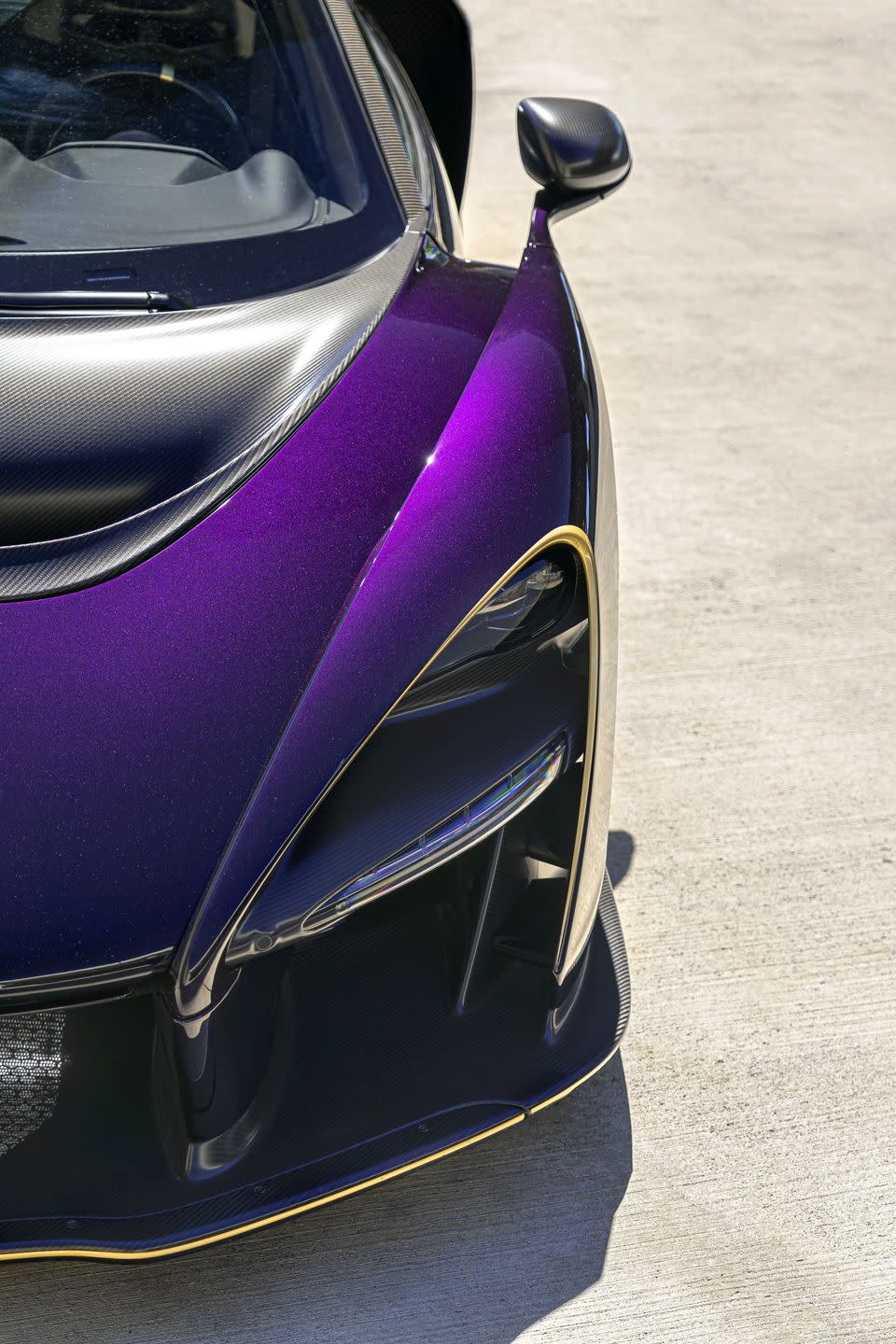
I fling up the butterfly door, clamber out of the carbon-fiber shell seat, and, I will admit, check the condition of the car’s body before hers. The rear license plate is on the ground (turns out it was held on only by Velcro), but the car is unharmed. And so presumably is the teenager, who gets up quickly, mounts her scooter, and is off. And that’s no small thing, since the McLaren Senna is entirely weaponized. It’s all sharp edges and exposed hot bits. I imagine getting hit by a Senna at any real speed would be like going through an industrial bread slicer.
It’s been more than 30 years since I last saw a McLaren on the streets of downtown Detroit. Evidence suggests that the city isn’t any more ready for it now than it was decades ago. I think, not for the first time today, “What the hell am I doing here?”
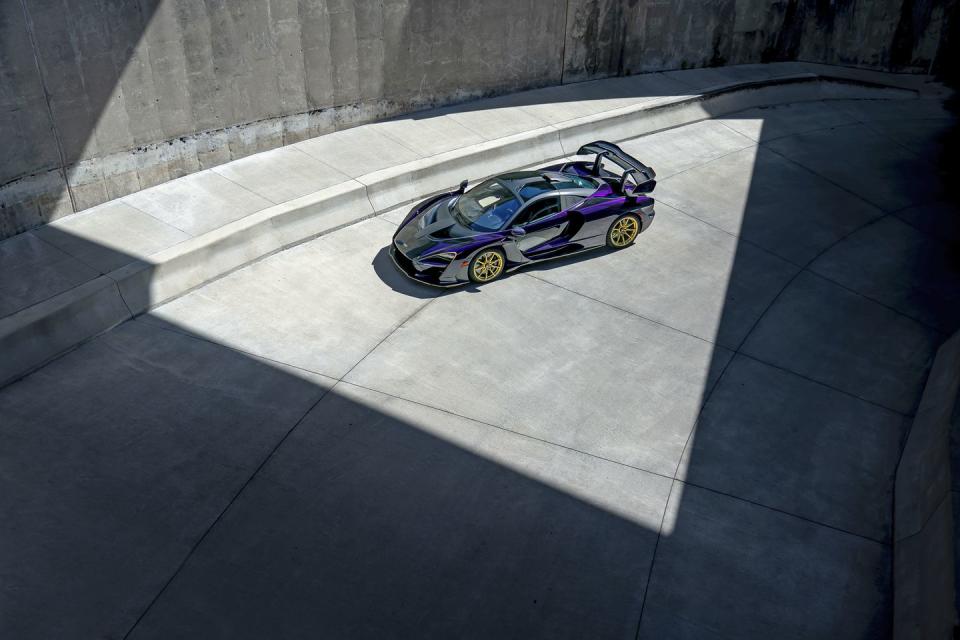
It's a legitimate question, just as it was in the summer of 1982 when the Formula 1 circus made its first stop in deeply distressed Detroit. Well, the motivation for Detroit was clear: Bring some positive national and international attention to the once-proud city that had become the butt of every joke. Apart from money, Formula 1’s motivations are less obvious.
What was clear from the start was that Detroit and Formula 1 were an odd pairing. Local sports columnists, accustomed to the simple oval pleasures of NASCAR and IndyCar, noted derisively that they couldn’t see the whole track from one spot. They whined that the race cars made too much noise. And anyway, who the hell has ever heard of a Brabham or a Williams or a McLaren? Yet every summer for seven years, the fancy men of F1 came to town with their loud, unfamiliar cars. Detroiters, sometimes shirtless and usually drunk, would attend. That’s because there ain’t no party like a Dee-troit party.
The drivers of the day pretty much hated the 2.5-mile Detroit circuit, even after some of the more tedious portions were taken out after the first running. None was more vocal than Alain Prost, ever the wet sock of F1. He never had to search for a sour comment. In the post-race press conference in 1988, Prost summed up his feelings with a succinct, “I hate this track.” In what must stand as the most Eighties description ever uttered, fellow French driver Patrick Tambay said driving the Detroit street circuit “was like riding the mechanical bull at Gilley’s.”
Even Ayrton Senna didn’t like the course, and he’d won the last three consecutive Detroit Grands Prix. The pavement of the bumpy city streets had a tendency to break up under the combined stresses of the race cars and the uterine heat of Michigan summers. And the Detroit circuit was the only F1 course that included a railroad crossing (suck it, Monaco!). His final win, in 1988, came at the wheel of one of the most graceful and utterly dominant Formula 1 cars of all time, the McLaren MP4/4. His teammate and increasingly bitter rival that year was Monsieur Prost. The 1988 season was not just a high-water mark for McLaren, which would win 15 of the 16 races. It was also the closing moments of the era of turbocharged Honda dominance.
It was around that time that a young F1 fan from the Detroit suburbs heard his first F1 car in real life. My dad agreed to take me to the Grand Prix, even though he couldn’t have cared less about the racing. It was there, by the spectator bridge just east of Detroit’s Renaissance Center, that I was confronted with the violence of a 1.5-liter V-6 going berserk on 12,500 revs and 36 pounds of turbo boost. It was Senna. And it was so loud I felt like I could see the sound, great rippling waves coming off the rear, turning the space between the concrete walls into a chute of shock and awe. I stood for some time wide-eyed, dumbfounded, shell-shocked.
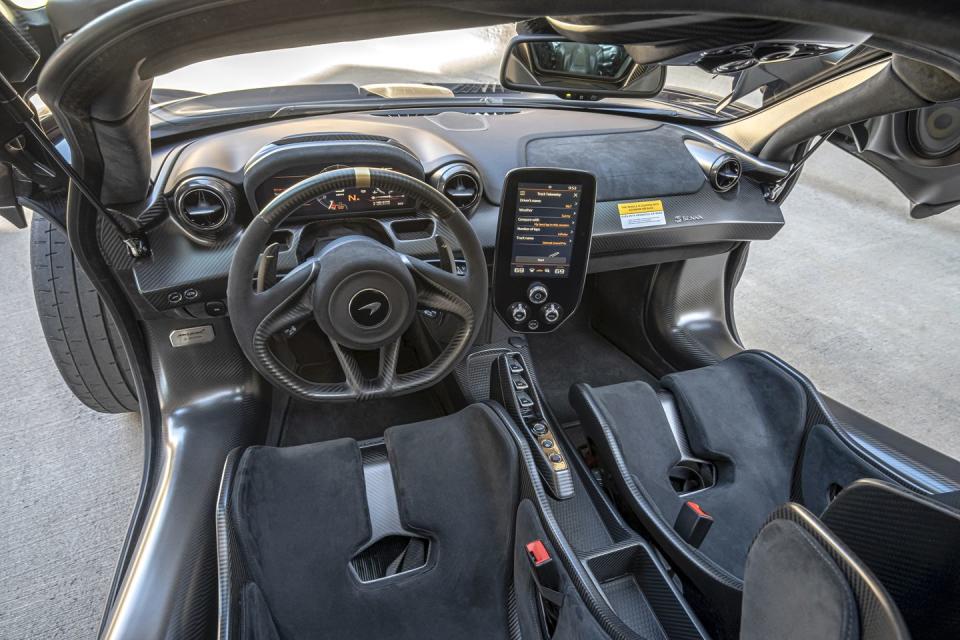
2019 MCLAREN SENNA
Price as tested:
$1,101,505
Length x width x height:
186.8 x 77.1 x 47.0 in
Wheelbase:
105.1 in
Engine:
Twin-turbo 4.0-liter V-8
Transmission:
7-speed dual-clutch automatic
Horsepower:
789 @ 7250 rpm
Torque:
590 lb-feet @ 5500 rpm
Curb weight:
2897 lbs
0-60 mph:
2.7 sec
EPA fuel economy:
14 city/18 highway
Dumbfounded fairly accurately describes the reaction of Detroiters to the McLaren Senna as I blasted around what remains of the Detroit Grand Prix course early on a recent Sunday morning. Through closed windows my drive became a silent movie of fellow drivers and pedestrians mouthing “OOOOHHHH DAAAAAAAMN!” Substituting for the typical pre-talkie piano accompaniment, this presentation was set to the insistent racket of the Senna’s 789-hp twin-turbo 4.0-liter V-8 inches behind my head.
The Senna is high street theater—this one wears gold eyeliner like some glam rocker, for goodness sake—but it’s also an alien invader. It lacks the animal grace of its predecessor, the 903-hp hybrid P1, and no one would call it a pretty thing. It surely is stunning, though. Like a modern Formula 1 car, the Senna was designed to appeal to the atmosphere, not the human eye. And like a current F1 car, it is festooned with all sorts of aerodynamic tabs and fences and nibs.
If its alligator-like profile, rooftop air scoop, massive articulating rear wing, top-mounted exhaust outlet, and odd aero addenda aren’t enough to pique interest, there’s always the doors, which not only open like butterfly wings but also carry fixed glass panels in the lower half. Presumably, the purpose of this four-figure option is to allow onlookers to confirm that the driver is, in fact, wearing pants.
Would those onlookers be disappointed to learn that sitting inside the Senna makes you feel like a baby bird inside a carbon-fiber shell? The seats are just hard panels with seven firm pads affixed. The floors are naked carbon fiber, covered only partially by floor mats. The dash is austere. There is effectively no sound-deadening material in this, the lightest current McLaren, so you hear every pebble that tinks off the underside of the car. The engine, which incidentally produces about 100 more horsepower than Ayrton Senna’s F1 Honda race engine from 1988, is loud enough under virtually all circumstances to overpower the optional Bowers & Wilkins audio system.
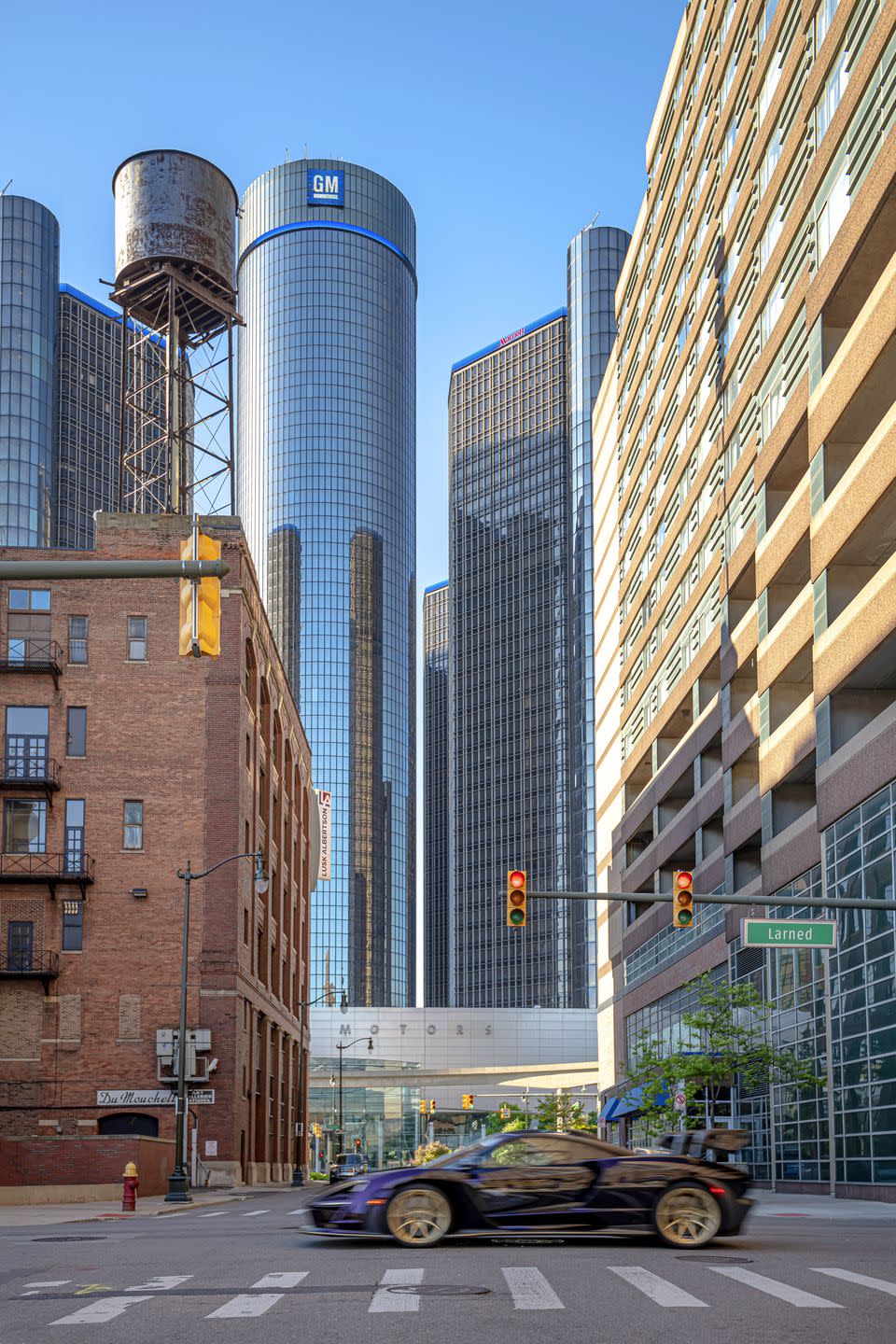
But it’s not just the engine’s audio that impresses. This most-powerful version of McLaren’s familiar V-8 floods the passenger cabin with waves of energy that excite different bodily sensors as the revs rise. At 4000 rpm, the resonance in the cockpit makes your right ear feel as if it’s stuffed with cotton. At 5000 rpm the bottom of the seat vibrates your ass vigorously. From 2000 rpm, the steering wheel buzzes with an intensity that builds as the engine nears its 8500-rpm redline. It’s near 7000 rpm that non-car-savvy passengers become convinced the engine is about to explode.
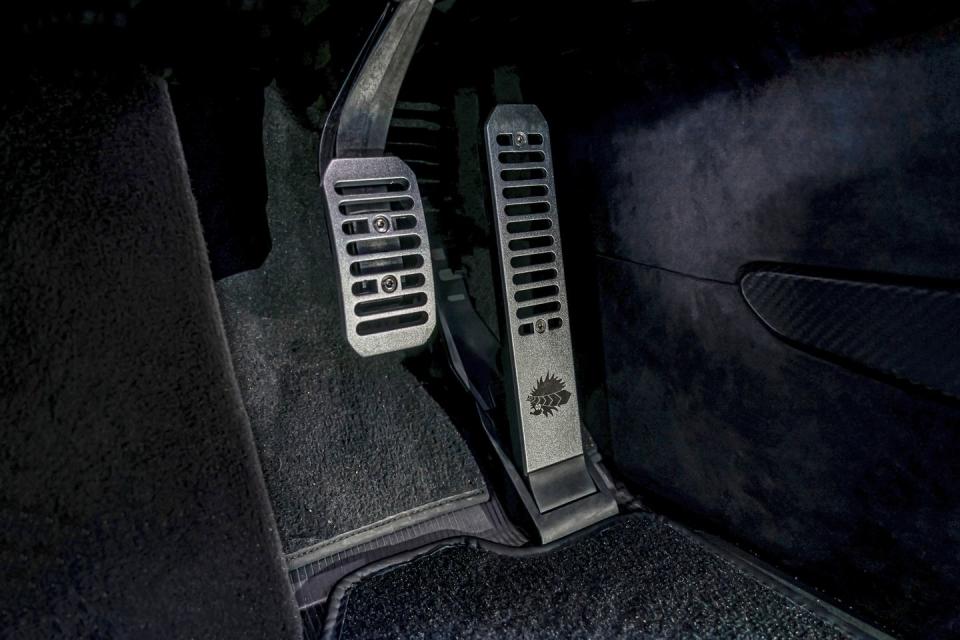
There aren’t many places to let the Senna loose on Detroit’s streets, even when they’re entirely abandoned. It’s a measure of downtown Detroit’s progress that you can only run about 80 percent of the old track. You can no longer drive the long straight beside the river, where the start/finish line once was. That’s now a public park. There’s a carousel where
Turn 1 used to be. The foot of Woodward Avenue, where race cars once blipped their throttles in front of the Spirit of Detroit statue, is now a pedestrian mall. You can still take a quick blast along Atwater Street, which formed a short chute between Turns 2 and 3 of the old circuit. A judicious throttle squeeze along the gentle curve in Congress Street before braking hard for the 90-degree left on Beaubien. A stab of throttle in the tunnel down by the river, but only a quick one because there’s a police substation just on the other side.
That it’s impossible to air out the Senna on downtown roads isn’t a surprise, of course. This is a vehicle capable of absurd speed and gut-slewing grip. It’s a car stuck between worlds, a track car that’s road legal but not road exploitable. It feels as confined in these surroundings as Senna’s McLaren MP4/4 must have.
Of course, even out on great roads far away from the city, the Senna is simply too much. Out there, its quick, communicative steering system shines. Its unyielding suspension tune is less jarring when it’s not dropping a wheel into the sunken manhole covers of the city. Even on smooth portions, the “Sport” suspension setting is as stiff as a reasonable person could sustain. The “Track” setting is too much. And the “Race” setting, which lowers the car nearly to the ground? Yeah, forget that. If you’re one of the 500 McLaren Senna owners, what you need is a racetrack. A big one. Where the car can generate its prodigious aerodynamic downforce, the tires can get nice and gummy, and the engine can vibrate every carbon panel to some approximation of ecstasy.
You still wouldn’t be living up to the car’s namesake, but at least you’re much less likely to get taken out by a teenager on an electric scooter.
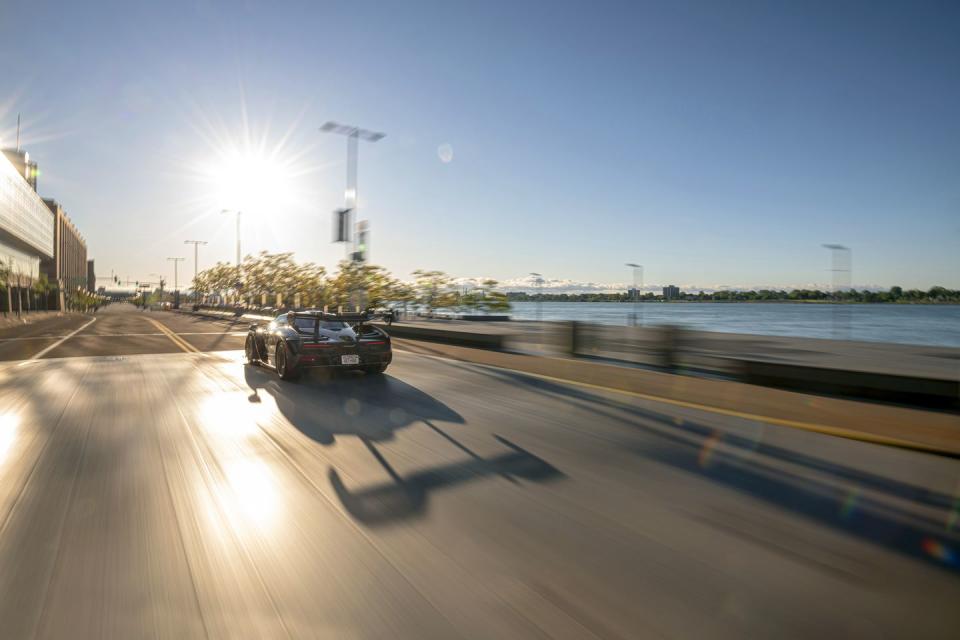
You Might Also Like

